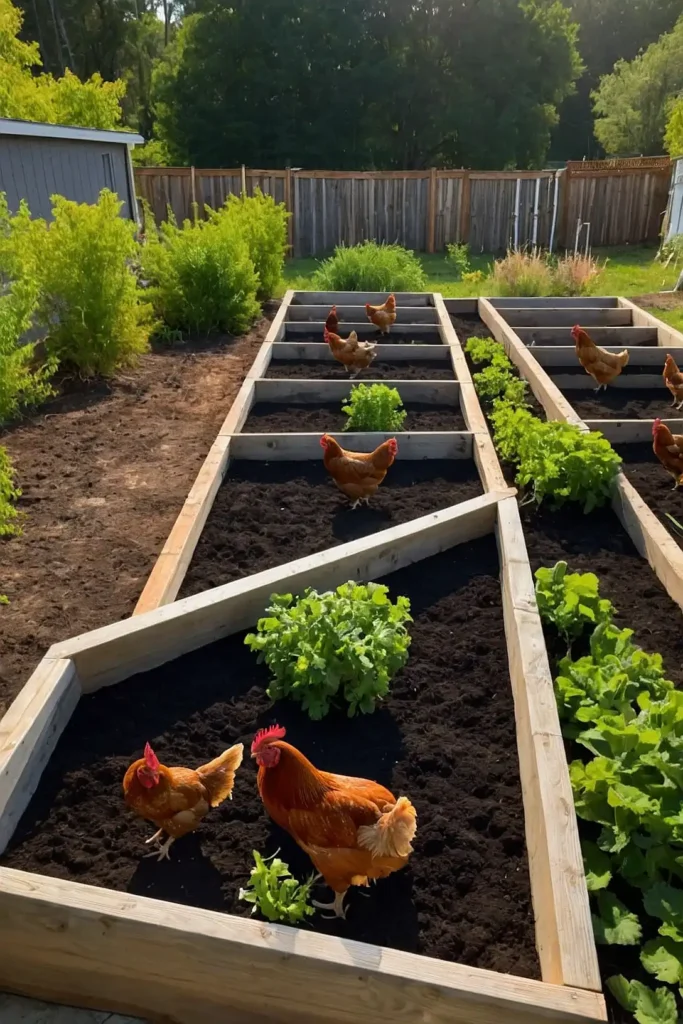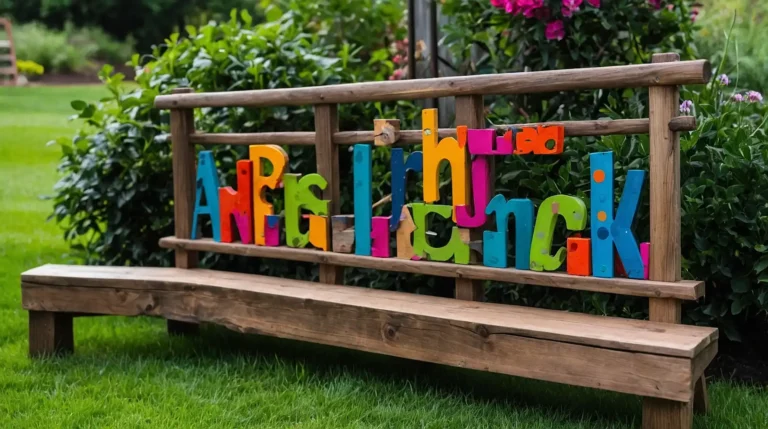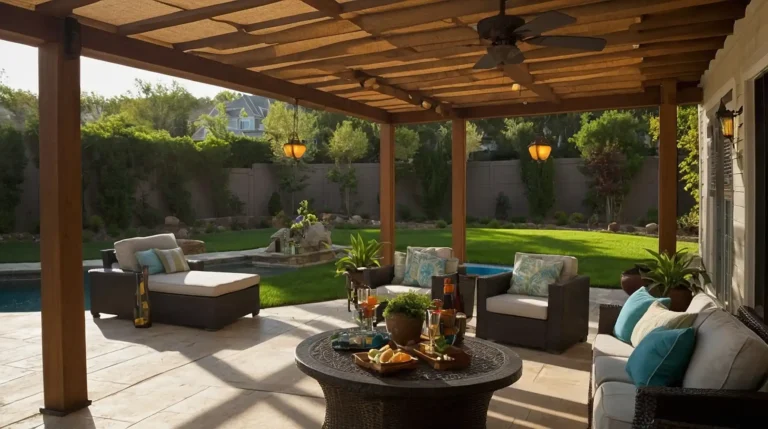27 Productive Homesteading Garden Layout Ideas to Maximize Your Harvest
Planning your homestead garden requires thoughtful design to maximize productivity in your available space.
The right layout can dramatically increase yields while reducing maintenance and making harvesting easier.
Whether you’re working with a small suburban lot or several acres, implementing strategic garden designs will help you grow more food with less effort.
Good planning also helps create a beautiful space that brings joy while providing for your family’s needs.
These 27 layout ideas will inspire you to design a homestead garden that balances productivity with sustainability.
Start with what works for your specific climate and space, then expand as you gain experience.
1: Four-Square Garden

Divide your garden into four equal sections separated by intersecting paths.
This classic design creates organized planting areas while providing easy access to all plants.
Rotate crop families through each square annually for natural pest control and soil health.
The central intersection creates a perfect spot for a small seating area or decorative element.
This traditional layout brings order to your homestead garden while honoring historical growing methods that have proven effective for centuries.
2: Keyhole Garden Beds

Create circular raised beds with a notched “keyhole” walkway extending to the center.
This efficient design allows you to reach the entire garden while minimizing compacted soil from foot traffic.
Place a compost bin in the center to make feeding your plants easy and efficient.
The decomposing materials provide nutrients and moisture directly to your growing vegetables.
This drought-resistant design conserves water while maximizing growing space, making it perfect for arid climates or water-conscious homesteaders.
3: Mandala Garden Design

Arrange circular beds in concentric rings around a central point like a water feature or herb spiral.
Connect the circles with spoke-like paths that provide easy access to all planting areas.
The curved beds create microclimate pockets that benefit different plant varieties.
This beautiful design mimics patterns found in nature while maximizing edge spaces where productivity thrives.
This visually striking layout transforms your homestead into a living artwork that produces food while honoring permaculture principles of interconnection.
4: Three Sisters Garden

Plant corn, beans, and squash together in traditional Native American groupings. The corn provides natural trellising for beans, while beans fix nitrogen in the soil.
Squash plants spread along the ground, suppressing weeds and keeping soil moist.
This companion planting approach maximizes vertical space while improving soil health.
This time-tested polyculture demonstrates how thoughtful plant combinations can create mutually supportive growing environments with minimal intervention needed.
5: Hügelkultur Mounds

Build raised mounds over buried logs and woody debris that gradually decompose, releasing nutrients and retaining moisture.
Create long, curved mounds that follow land contours for optimal water catchment.
Plant different crops on various parts of the mound according to their moisture needs. Upper sections remain drier while lower sections stay consistently moist.
This no-irrigation system builds soil fertility over time while putting woody waste to productive use, creating growing areas that improve with each passing season.
6: Market Garden Rows

Arrange crops in straight, uniform rows optimized for efficient harvesting and maintenance.
Standardize bed widths to match your tools and create paths wide enough for wheelbarrows or small equipment.
Group plants with similar heights, watering needs, and harvest times together for simplified maintenance.
This organized approach makes succession planting and record-keeping straightforward.
This commercial-inspired layout brings professional efficiency to your homestead, helping you grow significant quantities of food with streamlined work systems.
7: Cottage Garden Abundance

Mix vegetables, herbs, and edible flowers in informal, densely planted beds.
Emphasize vertical layering with taller plants backing shorter ones in an aesthetically pleasing arrangement.
Allow beneficial volunteer plants to thrive where they appear.
This biodiverse approach confuses pests while creating habitat for pollinators and beneficial insects.
This beautiful, productive chaos combines ornamental appeal with food production, proving that homestead gardens can be both useful and enchanting.
8: Herb Spiral

Construct a spiral-shaped raised bed that creates multiple microclimates in a small space.
Place drought-tolerant herbs at the top and moisture-loving varieties at the bottom.
The spiral shape maximizes edge space while creating varied sun exposures.
Different sections receive varying amounts of sunlight throughout the day, accommodating diverse herb needs.
This space-efficient design concentrates your most-used culinary and medicinal herbs in an easy-to-access, aesthetically pleasing feature near your kitchen.
9: Food Forest Layers

Mimic natural forest structures by planting in seven vertical layers from canopy trees to root crops.
Start with fruit and nut trees as your upper canopy, then add shrubs, herbaceous plants, ground covers, vines, and root crops.
Each layer serves multiple functions while maximizing three-dimensional growing space.
This diverse ecosystem reduces pest problems naturally while building soil health.
This low-maintenance approach creates a self-sustaining food landscape that increases in productivity year after year with minimal ongoing effort.
10: No-Dig Lasagna Beds

Create fertile growing areas without tilling by layering organic materials directly over grass or weeds.
Alternate “brown” layers (cardboard, leaves, straw) with “green” layers (kitchen scraps, fresh grass clippings, manure).
Arrange beds in accessible widths with clear pathways between. The decomposing layers smother weeds while creating rich soil teeming with beneficial organisms.
This soil-building technique allows you to expand your growing areas with minimal physical effort while recycling organic waste into valuable growing medium.
11: Circular Mandala Keyhole Garden

Combine the concepts of keyhole and mandala gardens by creating a circular bed with multiple keyhole access points.
This wheel-like design maximizes growing space while ensuring all plants remain within easy reach.
Place complementary plant guilds in each section to create mutually supportive micro-communities.
The abundant edges create diverse growing conditions for various crops.
This visually striking layout transforms garden maintenance from a chore into a meditative journey through interconnected growing spaces.
12: French Intensive Beds

Create deeply worked, raised beds with tightly spaced plants in a diamond pattern rather than rows.
This European method fits more plants into less space while reducing watering needs.
Position plants so their leaves will just touch at maturity, creating a living mulch effect.
The dense planting suppresses weeds while maximizing harvest from minimal square footage.
This intensive approach produces remarkable yields from small spaces, making it ideal for homesteaders with limited land but abundant time for careful maintenance.
13: Square Foot Garden Grid

Divide raised beds into 1’×1′ squares, planting each square with a specific number of plants based on their size at maturity.
Use a physical grid made of string or lath to visualize these planting areas.
Fill the beds with a perfect soil mix for optimal growth. This methodical system eliminates guesswork while ensuring proper spacing for plant health.
This beginner-friendly approach provides clear organization and prevents overplanting while maximizing productivity in small homestead gardens.
14: Permaculture Zones Layout

Organize your entire homestead into concentric zones based on how frequently you need to access different elements.
Place daily-use herbs and greens in Zone 1 nearest your kitchen door.
Position Zone 2 for frequently tended annual vegetables, Zone 3 for fruit trees and perennials, and so on.
This thoughtful arrangement minimizes unnecessary walking while ensuring regular observation of all growing areas.
This holistic design approach integrates your garden into your daily life patterns, saving time and energy while increasing your connection to the land.
15: Hügelkultur Terraces

Create a series of hügelkultur mounds that follow land contours on sloped properties.
Each terrace captures rainfall, preventing erosion while creating level growing areas on challenging terrain.
Plant different crop groups on each terrace based on water and sun requirements.
The varied elevations naturally create different microclimates for diverse growing conditions.
This hillside solution transforms problematic slopes into productive growing spaces while capturing valuable water that would otherwise run off.
16: Espalier Fruit Tree Fence

Train fruit trees to grow flat against walls or fences in decorative patterns.
This space-saving technique allows you to grow multiple varieties in areas too narrow for standard trees.
The two-dimensional growth pattern increases sun exposure for better fruit ripening.
Plant complementary understory crops beneath these living fences for maximum space utilization.
This historical technique combines ornamental beauty with productive function, perfect for homesteaders seeking to maximize edge spaces and boundaries.
17: Edible Landscape Foundation Plantings

Replace traditional ornamental foundation plantings with beautiful edibles that serve multiple functions.
Blueberry bushes, dwarf fruit trees, and attractive herbs create curb appeal while providing food.
Design with four-season interest in mind, incorporating plants with spring blossoms, summer fruit, fall color, and winter structure.
This approach integrates food production into even the most visible parts of your property.
This dual-purpose approach eliminates the artificial boundary between “yard” and “garden,” expanding your growing space while maintaining an attractive property appearance.
18: Chicken Moat System

Create a double-fenced pathway around your garden where chickens patrol for pests.
The birds can’t access your crops but can catch insects and weed seeds that would otherwise enter the garden.
Rotate portable chicken housing along this perimeter to distribute manure evenly.
This integrated system turns pest management into egg production while improving soil fertility.
This protective barrier makes your chickens garden allies rather than destructive pests, creating symbiosis between your livestock and vegetable production.
19: Bamboo Dome Trellis Garden

Construct dome-shaped bamboo trellises as the centerpiece of garden beds.
Plant climbing crops like beans, peas, and cucumbers that will grow up and over these structures.
Shade-tolerant crops like lettuce and spinach thrive underneath the dappled light of the vine-covered dome.
This three-dimensional growing technique multiplies your harvest from the same footprint.
This architectural approach creates magical growing spaces that invite exploration while maximizing vertical production in your homestead garden.
20: Solar-Powered Rotation

Arrange garden beds on a north-south axis with tall crops on the northern end, medium-height crops in the middle, and short crops on the southern end.
This strategic positioning ensures all plants receive appropriate sunlight.
Plan your rotation to maintain this height progression throughout the season. The stair-step approach prevents taller plants from shading shorter ones.
This sun-conscious design maximizes photosynthesis for all your plants, increasing overall garden productivity through thoughtful spatial arrangement.
21: Pollinator Pathway Garden

Design your homestead garden with intentional corridors that connect pollinator habitats.
Interplant vegetables with flowering herbs and native blooms that support beneficial insects.
Create continuous bloom throughout the growing season by selecting plants with sequential flowering times.
This diversity ensures your garden never lacks for pollinators when crops need them.
This ecological approach improves fruit set and seed production while supporting declining pollinator populations and increasing overall biodiversity on your homestead.
22: Urban Intensive Grid

Maximize limited city space with tightly arranged raised beds featuring mesh-reinforced corners for attaching hoops, trellises, or cold frames as needed.
Keep beds narrow enough to reach the center from either side.
Eliminate permanent pathways by using stepping stones that can be moved as needed.
This flexibility allows you to reconfigure your growing space seasonally based on current needs.
This adaptable system makes even tiny spaces remarkably productive, bringing homestead self-sufficiency to urban and suburban environments.
23: Vertical Wall Gardens

Transform fences and walls into productive growing space using pocket planters, gutter systems, or trellis panels.
These vertical elements add significant growing area without increasing your garden’s footprint.
Select appropriate crops like strawberries, lettuce, herbs, and compact vegetables that thrive in these space-saving systems.
Install drip irrigation for easy watering of these elevated plantings.
This upward expansion dramatically increases your homestead’s productivity while creating living walls that add beauty and habitat to your landscape.
24: Drought-Resistant Sunken Beds

Create recessed growing areas 6-12 inches below ground level to collect and conserve moisture.
This ancient technique, used in desert regions for centuries, reduces watering needs dramatically.
Incorporate organic matter to improve soil water retention.
The lowered profile protects plants from drying winds while collecting dew and rainfall more effectively.
This water-wise approach allows productive gardening in arid climates while building resilience against increasing drought conditions and water restrictions.
25: Four-Season Succession Planning

Design your garden layout with year-round production in mind by dedicating different areas to seasonal crops.
Designate protected beds near south-facing walls for winter harvests.
Create detailed planting schedules to ensure continuous production.
Plan for quick-growing crops between longer-season varieties and fall/winter vegetables following summer harvests.
This strategic approach keeps your homestead producing food through all seasons, increasing self-sufficiency and reducing dependence on store-bought produce.
26: Root Cellar Integration

Position root and storage crop gardens close to your preservation facilities. Design these beds for easy harvest in large quantities rather than continuous picking.
Group foods with similar storage requirements together for efficient processing.
This thoughtful proximity reduces handling time and spoilage during the critical harvest period.
This preservation-minded layout acknowledges that growing food is only part of the equation—storing it efficiently completes the self-sufficiency cycle.
27: Silvopasture Garden Edges

Integrate tree crops along pasture edges with protective fencing that allows livestock to graze underneath without damaging the trees.
This frontier zone becomes highly productive multi-layered growing space.
Plant fruit and nut trees with sufficient spacing to allow light to reach understory plantings.
Grazing animals provide natural fertilization while keeping grass competition in check.
This boundary-blurring approach creates synergy between your orchard and livestock systems while maximizing land use through strategic layer stacking.
Conclusion
Your homestead garden should evolve alongside your skills and needs.
Begin with layouts that match your current capabilities, then experiment with more complex systems as you gain confidence in your growing abilities.







